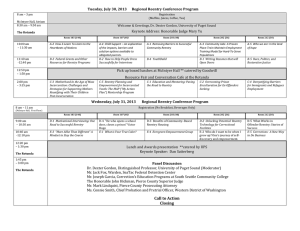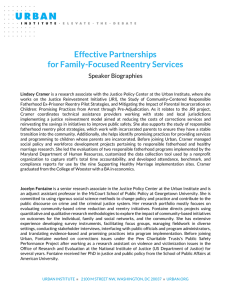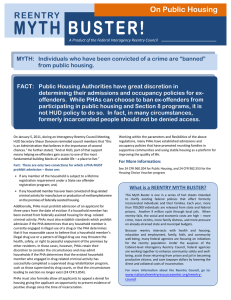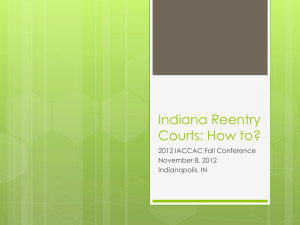Prisoner Reentry: Addressing the Challenges in Weed and Seed
advertisement
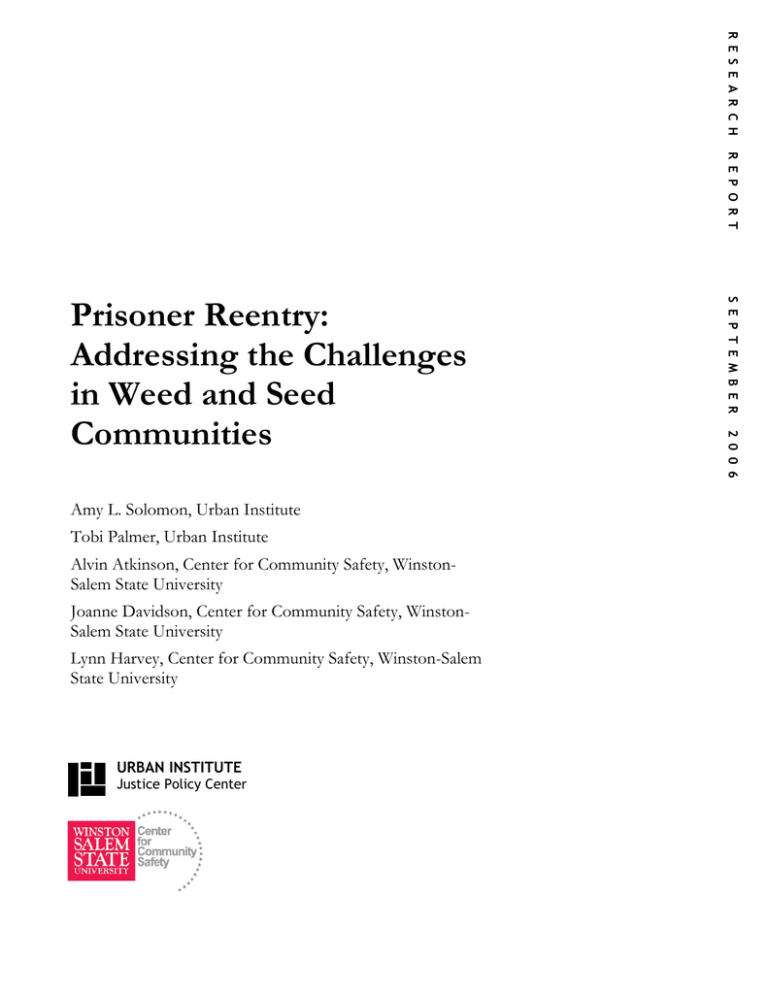
R E S E A R C H R E P O R T Tobi Palmer, Urban Institute Alvin Atkinson, Center for Community Safety, WinstonSalem State University Joanne Davidson, Center for Community Safety, WinstonSalem State University Lynn Harvey, Center for Community Safety, Winston-Salem State University URBAN INSTITUTE Justice Policy Center 2 0 0 6 Amy L. Solomon, Urban Institute S E P T E M B E R Prisoner Reentry: Addressing the Challenges in Weed and Seed Communities URBAN INSTITUTE Justice Policy Center 2100 M Street NW Washington, DC 20037 www.urban.org © 2006 Urban Institute This report was prepared under grant number 2005-WS-Q5-K005 awarded to the Center for Community Safety by the Bureau of Justice Assistance, Office of Justice Programs, U.S. Department of Justice. Opinions expressed in this document are those of the authors, and do not necessarily represent the official position or policies of the U.S. Department of Justice, the Center for Community Safety, or the Urban Institute, its trustees, or its funders. Prisoner Reentry: Addressing the Challenges in Weed and Seed Communities 2 Prisoner Reentry: Addressing the Challenges in Weed and Seed Communities E ach year, more than 650,000 prisoners are released from state and federal prisons, and more than 12 million cycle through local jails (Harrison and Beck 2005; Beck 2006). Taken together, this large volume of people moving in and out of correctional institutions impacts public safety, public health, family networks and community wellbeing—especially in disadvantaged neighborhoods already affected by crime, unemployment, and other factors (Travis et al, 2001). Coalitions across the country are developing innovative strategies to address the challenges of prisoner reentry. In order to understand the extent to which Weed and Seed sites are engaged in prisoner reentry efforts—and to foster peer-to-peer support among sites—the Department of Justice’s Community Capacity Development Office, the Center for Community Safety of WinstonSalem State University, and the Urban Institute surveyed Weed and Seed sites around the country. This report summarizes the responses from the survey, illustrating the various ways that Weed and Seed sites are focusing on prisoner reentry and working with partner organizations to reduce recidivism and create safer, healthier communities.1 Weed and Seed Involvement in Prisoner Reentry In late 2005, the vast majority of Weed and Seed sites (a total of 308) were surveyed about their involvement in prisoner reentry efforts. One hundred eighty-four sites responded to the survey (60 percent). Eighty-eight sites (48 percent of respondents) reported that they were tackling the issue of prisoner reentry in their community. Specifically, these 88 sites indicated “very extensive” or “fairly extensive” activities by community and faith-based organizations related to reentry and/or stated that they have adopted prisoner reentry as part of their formal Weed and Seed strategy. For the majority of these reentry-involved sites (60 percent), reentry is both a “weeding” and a “seeding” strategy. In terms of geographic boundaries, about half of the reentry efforts are limited to designated Weed and Seed areas and the other half are part of broader initiatives. Accordingly, while a quarter of the sites have received Weed and Seed Special Emphasis funding for reentry, several sites rely on additional funding to carry out their reentry efforts (or have a relationship with other federal programs). For example, 22 percent of the reentry-involved sites report they have received funding for reentry from another federal agency, and 17 percent are coordinating with their local Serious and Violent Offender Reentry Initiative site. Target Populations for Reentry Programs In terms of demographics, most Weed and Seed reentry programs serve both men and women (72 percent) and focus on the adult population. Additionally, 18 percent report serving juveniles and 16 percent focus on the children of incarcerated adults. Several sites serve multiple reentry populations. Prisoner Reentry: Addressing the Challenges in Weed and Seed Communities 3 Table 1. Sites with “Very Extensive” Reentry Activities Site Location Boston ClintonHill Communitywide Congress Heights East Beach Street Edgecliff Garfield Grove Hall Highland Park North Side Northend Northwest Northwest Austin Oklahoma City Reading San Antonio Springfield Thompson-Hunter Community Partnership Boston, MA Newark, NJ Lima, OH Washington, DC Holyoke, MA Spokane, WA Phoenix, AZ Boston, MA Highland Park, MI Omaha, NE Hamilton, OH Dayton, OH Chicago, IL Oklahoma City, OK Reading, PA San Antonio, TX Springfield, MA Raleigh, NC For the remainder of this report, all percentages (unless otherwise noted) refer to the 88 reentry-involved sites, not all 184 sites that responded to the survey. Note: These sites described activities by community and faith-based organizations related to the reentry of prisoners into their community as being “very extensive.” Participation in reentry programs is voluntary in most cases (64 percent). Even so, most sites (77 percent) note that the need for services is larger than their program capacity. Importantly, about two-thirds of sites (63 percent) believe their community is favorable to their reentry efforts. About 40 percent of the reentry programs target all ex-offenders returning to the Weed and Seed area (figure 1). Twenty-one percent of sites focus on recently released ex-offenders, 15 percent target nonviolent ex-offenders, and another 15 percent serve specialized subsets of people, such as those with a mental illness or those under community supervision. Ten percent of sites specifically target serious and violent exoffenders. Just over one quarter of the programs (27 percent) excludes certain individuals. The most frequently cited exclusions were sex offenders and violent offenders. Reentry Programs and Strategies Weed and Seed sites provide a range of services to individuals in their reentry programs. Forty-one percent of sites describe their reentry service provisions as comprehensive, aiming to address a wide range of challenges confronting returning prisoners. On the other hand, some sites’ programs focus on a targeted service area, most commonly employment services and housing assistance. Weed and Seed sites utilize various reentry strategies both before and after prisoners are released (figure 2). Prior to release, case management, faith-based services, housing, and individual reentry planning are most frequently offered. The majority of reentry Prisoner Reentry: Addressing the Challenges in Weed and Seed Communities 4 strategies are provided after a person has been released from prison or jail. The most common postrelease services offered include case management, employment training, housing assistance, reentry plan development, faith-based services and educational programs. Figure 1. Reentry Target Population Serious and violent exoffenders 10% A subset of ex-offenders with specific service needs 15% Nonviolent ex-offenders 15% Recently released and/or all parolees 21% All identified ex-offenders 40% 0% 5% 10% 15% 20% 25% 30% 35% 40% 45% Figure 2. Percentage of Sites that Employ Various Program Strategies before and after an Individual Is Released 70% Prerelease Postrelease 60% 50% 40% 30% 20% 10% 0% l t s s s n nt e nt ng ng na en ice tio ice nc i ce ini eli me tio v v u me m a v l s a r r t t p a r r e o n e s e t a c i lo se ag ls ou nt tre du ss res ds ve an ion nta ct hc se de me y/e se i ga t m s l l e a y i c u f n n i a d b v o b n r la se pl us era he ith /or pe /co ea yp Ca Lit Ho Em tal nd Fa nc ice /su n l t ntr a a t e s o l e u M bs ntr i ca Re ej Su ed Co tiv a M r sto Re Prisoner Reentry: Addressing the Challenges in Weed and Seed Communities 5 Program Size Only 33 sites reported the size of their reentry program. Of those, about half (15 sites) stated they served fewer than 50 clients the previous year. Other initiatives are larger: nine sites reported serving 51 to 100 clients, five sites reported serving 101 to 199, and four sites reported having served more than 200 clients in the previous year. Expected Outcomes Several sites identified the outcomes they hope their reentry efforts will achieve. Of those who provided such information, 38 percent stated that reducing recidivism was their most important outcome. Thirty percent of sites indicated improved employment-related outcomes as their top priority, and 19 percent reported increased community support as their main objective. About half the sites stated that they are measuring and tracking program outcomes; one-quarter of the sites track outcomes via an electronic database. Table 2. Sites Using an Electronic Database to Measure and Track Outcomes Site Location Barriada Morales Burbank Area Campello Central East Charlottesville CNN Communitywide Congress Heights Downtown/Millyard East Aurora (Kane) East Beach Street Fort Wayne Grove Hall North Side Northend Northwest Austin Oklahoma City Phillip's Expansion Pleasant Grove Racine South Salt Lake City Winston-Salem Caguas, PR Santa Clara County, CA Brockton, MA Austin, TX Charlottesville, VA Indianapolis, IN Lima, OH Washington, DC Manchester, NH Aurora, IL Holyoke, MA Ft. Wayne, IN Boston, MA Omaha, NE Lima, OH Chicago, IL Oklahoma City, OK Minneapolis, MN Dallas, TX Racine, WI Salt Lake City, UT Winston-Salem, NC Partner Organizations in Weed and Seed Reentry Efforts Weed and Seed reentry initiatives—like virtually all Weed and Seed efforts—involve multiple law enforcement and community-based partners. The most common reentry partners are faith-based organizations, vocational training and employment agencies, and substance abuse service providers. Prisoner Reentry: Addressing the Challenges in Weed and Seed Communities 6 Specifically, more than two-thirds (68 percent) of Weed and Seed sites working on reentry report that faith-based organizations are involved in their reentry efforts. Just over half report involving each of the following: an employment or training agency, substance abuse provider, housing organization, or restorative justice/community service agency. Between 40 and 50 percent of the reentry coalitions also include organizations that provides family support, mental or physical health, and education services. Various agencies lead the local reentry efforts. Of the 38 sites that Table 3. Types of Agencies that Lead Weed and Seed Reentry Efforts addressed this topic in their survey Agency type Number of sites response, about two-thirds reported 11 that a law enforcement or correctional Department of Correction 8 agency serves as lead agency, and Community organization Law enforcement 7 about one-third reported that a Faith-based organization 6 community or faith-based agency fills Probation or parole 6 this role (table 3). The Weed and Seed/VISTA Reentry Initiative The Corporation for National and Community Service has partnered with the Department of Justice’s Community Capacity Development Office to develop and implement an AmeriCorp*VISTA (Volunteers in Service to America) and Weed and Seed reentry collaborative that builds the capacities of Weed and Seed communities to support reentry initiatives. This three-year initiative is enabling AmeriCorp*VISTA members to build the capacity of organizations and create volunteer hubs in partnership with faith-based and community groups in 12 selected Weed and Seed cities in the United States: Philadelphia, Chicago, Miami, Indianapolis, Cleveland, Dayton, Charleston, Portland, Dallas, Providence, Oakland, and Washington, D.C. The primary goals of the initiative are to reduce ex-offender recidivism and crime, promote successful reentry into society, and to build capacity for reentry and mentoring initiatives using AmeriCorps*VISTA members. Sites are encouraged to develop or enhance reentry initiatives by working through a strategic planning model that involves the following: 1. Establishing a reentry committee 2. Identifying needs to be addressed 3. Establishing reentry strategy goals and objectives 4. Selecting a target population 5. Selecting a target area 6. Identifying key decisionmakers 7. Designing a service delivery plan for each phase of reentry 8. Organizing project management 9. Identifying available resources 10. Developing and implementing an evaluation tool For additional information about the initiative, contact the Community Capacity Development Office (http://www.ojp.usdoj.gov/ccdo/programs/reentry.html#special_emphasis) or the Center for Community Safety at Winston-Salem State University (http://www.centerforcommunitysafety.org). Prisoner Reentry: Addressing the Challenges in Weed and Seed Communities 7 Innovative Practices Several sites are engaged in innovative reentry efforts (figure 3). For example, 45 percent report using mapping technology to document the neighborhoods where prisoners are returning or where services are located. Notably half of those who are not “mapping reentry” indicate they would like to do so. Forty-two percent of sites are connecting recently released prisoners with mentors in their community, and about a third use “onestop shops” to provide access to a variety of treatment and support providers at a single location. One-third of the sites report using notification call-in sessions, where service providers, faith-based organizations, and law enforcement agencies deliver dual messages—of individualized support to assist in transitioning back into the community and severe consequences for reengaging in criminal activities. This strategy was originally used in Boston and other cities to reduce gun and gang violence, and is now being adapted for the reentry context. Approximately 27 percent of the sites report utilizing some form of group, circle, or board composed of community members, resource organizations, corrections personnel, ex-offenders, and others who participate in the development and oversight of reintegration plans for ex-offenders based on systems of accountability and responsibility. Finally, 14 percent of sites are working with reentry courts that leverage judicial authority to apply sanctions and rewards and marshal resources in the community. Figure 3. Innovative Reentry Practices Reentry courts 14% Citizen Circles/family group conference 17% Community accountablity board 17% Offender specific reentry teams 23% Notification call-in session 32% One-stop shop 32% Mentors 42% Mapping 45% Percentage of Weed and Seed sites In terms of innovative approaches to particular substantive areas, many Weed and Seed sites work creatively within their jurisdictions to address some of the most difficult challenges of reentry, such as securing housing, getting a job, and restoring ex-offenders’ ties to families and communities. Some examples described in the survey responses are included below. Prisoner Reentry: Addressing the Challenges in Weed and Seed Communities 8 Housing o The Oklahoma Housing Authority has allowed a staff member from Oklahoma Weed and Seed to serve as an ex-officio employee, taking applications and other required documentation for housing units. The reentry specialist can go into the prison several months prior to an individual’s release to have the prisoner fill out a housing application. The person is placed on a waiting list, and, in six or more months, their name comes up to the top of the list for the next apartment. If the individual is still incarcerated, his or her name is put on hold, and, once released, he or she will receive the next available apartment. This is a substantial change from business-as-usual; typically, an ex-offender would go to the Housing Authority after release to inquire about an apartment, submit an application, and most likely be put on a six-month or longer waiting list. o In Reading, Pennsylvania, Weed and Seed is working with local landlords to provide postrelease housing. Landlords are open to participating because they will have the assistance of the ex-offender’s parole officer and the reentry coordinator to address housing issues that may arise. In addition, prior to release, incarcerated persons receive training regarding their responsibilities as tenants and how to address potential issues with their landlord. o In Toledo, North River Weed and Seed is part of a housing group studying and identifying issues that property managers housing ex-offenders need to address. A curriculum is under development and will be circulated upon completion. Employment o In Indiana, Fort Wayne’s Weed and Seed works with the Fort Wayne Reentry Court to address employment and vocational training for ex-offenders. The court has developed an intensive, two-week, 30-hour Employment Academy that attempts to address barriers associated with employment and provides training services and transitional jobs for returning offenders. Also, a non-profit, Bluejacket, Inc., was formed to develop additional training and transitional employment opportunities for individuals returning from incarceration. This non-profit agency has developed a construction-training course certified by the local Ivy Tech College and provides college credit upon completion. o Thompson-Hunter Community Partnership Weed and Seed in Raleigh, North Carolina, is part of a collaborative effort to provide comprehensive job training and skills development for ex-offenders as well as wraparound support services. The REPAIR (Reentry Entrepreneurial Partnerships Aimed at Individual and Community Restoration) project is a collaboration effort of Thompson-Hunter Community Partnership, North Carolina Department of Corrections, Probation and Parole, Capital Area Workforce Development, Wake Technical Community College, and Passage Home CDC. Participants of the REPAIR program assist with community restoration efforts and are integrated back into their communities by providing reliable and valuable community service projects. Prisoner Reentry: Addressing the Challenges in Weed and Seed Communities 9 Family o Northwest Weed and Seed in Dayton, Ohio, is involved with the Common Sense Parenting program (Boys Town Press) within Ohio Correctional Institutions. The program brings children and the custodial parent into the institution for sessions with the incarcerated family members to help build strong family ties and parenting models and ensure a more seamless transition to family life when the inmate is released. o In Spokane, Washington, Edgecliff Weed and Seed has established high-risk youth programming in local schools as well as parenting classes to reach offenders’ families in mainstream settings. Community o Albina Weed and Seed in Portland, Oregon, is in the process of launching a new program in which incarcerated individuals are nominated to become AmeriCorp members. They will participate in six months of community responsibility classes prior to release. Upon release, they will become traditional AmeriCorp members, working in the community on capital improvement projects. These projects will not only rebuild community trust but provide formerly incarcerated persons with a tangible experience in which they can take pride. o In Chicago, the Northwest Austin Weed and Seed has a Community Support Advisory Council (CSAC) with a director of prison reentry who conducts two CSAC classes each month at Sheridan Correctional Center to teach inmates the role of the community in their return; to prepare them for the challenges and opportunities they may encounter on the outside; and to teach them how to obtain basic necessities, such as state-issued identification and transportation assistance. Upon release, individuals participating in this program continue to meet with CSAC staff, in conjunction with their probation officer and TASC staff, to help address any challenges and issues they may experience once released. In addition, program participants are encouraged to attend ex-offender support groups in the community. o The Tacoma Weed and Seed is involved in the Washington State Department of Correction’s Risk Management Intensive Transition (RMIT) team. High-risk offenders are targeted before release and RMIT teams help them develop a plan to transition back to the community. Teams are made up of local service providers and individuals who, by nature of their roles, can influence the ex-offender’s ability to follow his or her release plan and assist the Department in managing the risk the exoffender poses. In addition, for eligible individuals, funding is available for 90 days after release for housing, transportation, food, work clothes, and necessities that support a successful transition into the community. Barriers to Reentry Programming Weed and Seed sites point to several barriers that make it difficult to implement effective reentry programs and services. The top three barriers noted were keeping participants engaged in services, meeting the housing needs of the population, and convincing employers to hire ex-offenders (table 4). Prisoner Reentry: Addressing the Challenges in Weed and Seed Communities 10 Table 4. Barriers to Reentry Programming Barrier Participant persistence with services Ensuring housing needs Convincing employers to hire Coordinating agencies Ensuring delivery of mental health and substance abuse services Relationships with community partners Education accessibility Keeping families connected Identifying eligible participants early enough Tracking success and failure Steering committee awareness and buy-in Ensuring safety of providers Sites reporting barrier (%) 42 41 40 27 26 17 16 14 14 14 14 11 Technical Assistance Needs Weed and Seed sites indicated a desire for technical assistance and training related to reentry programming. The most frequently cited areas—aside from how to access additional funding—were job training and placement, integrating former prisoners into the community, and connecting individuals with stable housing. Experienced Weed and Seed Sites Are a Resource The experience and expertise of current Weed and Seed sites are a valuable resource for new and potential Weed and Seed sites seeking to develop prisoner reentry strategies. Table 5 lists sites engaged in reentry efforts and willing to share information or mentor Weed and Seed sites that are new to the issue of prisoner reentry. To identify current staff working in these sites, please see the Weed and Seed Contact Directory within the Weed and Seed Data Center at http://www.weedandseed.info/. In addition, sites interested in developing reentry programs can benefit from a broad range of organizations that have done work in this field. For a listing of key web sites, publications, electronic newsletters, and listservs about prisoner reentry, see “A Reentry Resource Guide for Weed and Seed Sites.”2 The guide provides links to select resources relating to a variety of reentry topics, including employment, health, housing, and substance abuse. It also includes sections on mapping and neighborhood strategies, volunteerism, and community initiatives. Another valuable resource for sites is the “Report of the Re-Entry Policy Council,” authored by the Council of State Governments and ten organizational partners. The report provides policy recommendations for the safe and successful return of prisoners to the community, reflecting the consensus of a wide range of experts and associations engaged in the topic.3 In particular, the first section of the report describes the essential first steps necessary for any community seeking to establish a new reentry initiative. The major topics covered include encouraging collaboration among stakeholders, developing a knowledge base, strategies for funding a reentry initiative, measuring outcomes, and educating the public.4 Prisoner Reentry: Addressing the Challenges in Weed and Seed Communities 11 Table 5. Weed and Seed Sites Willing to Share Information about Their Reentry Activities and/or Serve as a Peer Mentor to Other Weed and Seed Sites Site Location Area of Reentry Albina Portland, OR General Central Expansion Minneapolis, MN General Communitywide Lima, OH General Congress Heights Washington, DC General Ft. Wayne Ft. Wayne, IN General Immokalee Immokalee, FL General Indianapolis Indianapolis, IN General Northend Hamilton, OH General Northwest Dayton, OH General Pleasant Grove Dallas, TX General Racine South Racine, WI General Washington Park/Allen Park North Miami Beach, FL General West Oakland Oakland, CA General East Beach Street Holyoke, MA Community partnerships Mott Haven Bronx NY Community partnerships Reading Reading, PA Community partnerships Barriada Morales Caguas, Puerto Rico Employment Grand Prairie Grand Prairie, TX Employment Highland Park Highland Park, MI Employment Burbank Area Santa Clara County, CA Juvenile reentry Central Cedar Rapids, IA Mental health CNN Indianapolis, IN Mental health MLK Area-CDC Chattanooga, TN Network building Grove Hall Boston, MA Partnerships Oklahoma City Okalahoma City, OK Partnerships Phillips Expansion Minneapolis, MN Partnerships San Antonio San Antonio, TX Partnerships and awareness Thompson-Hunter Raleigh, NC Partnerships and employment Community Partnership Edgecliff Spokane, WA Partnerships and family reintegration East Aurora (Kane) Aurora, IL Partnerships and mentoring Communitywide Lima, OH Reentry court Tacoma Tacoma, WA Sex offenders Campello Brockton, MA Technology Looking Forward The results of the survey described in this report suggest a substantial number of Weed and Seed sites are actively engaged in efforts to improve the odds of successful reentry. Many sites characterize their involvement in the topic as “extensive,” and their programs address a broad range of challenges associated with prisoner reentry. Weed and Seed sites are working both inside prisons and in communities to provide case management and assistance with employment, housing, treatment, and health issues. Their coalitions are broad-based, involving a range of law enforcement and correctional agencies, service providers, and faith-based organizations. As a result, reentry strategies largely incorporate both the “weeding” and “seeding” aspects inherent to the Weed and Seed philosophy. Prisoner Reentry: Addressing the Challenges in Weed and Seed Communities 12 Given that prisoners return to a small handful of communities in each state— including Weed and Seed neighborhoods—there is an enormous opportunity for Weed and Seed coalitions to continue to develop and enhance their reentry efforts. Practitioners and policymakers around the country are seeking practical solutions to this multifaceted issue and are aiming not only to reduce crime, but to improve public health, strengthen families, enhance community well-being, and efficiently utilize scarce resources. The challenges of reentry are great, but community and faith-based organizations—along with their law enforcement partners—may be in the best position to create lasting partnerships that can improve reentry and reintegration outcomes along a number of dimensions. Notes 1. For a copy of the survey and a compilation of the responses, please contact Joanne Davidson at davidsonj@wssu.edu or see http://www.centerforcommunitysafety.org. 2. This report will be published in the fall of 2006. See the Center for Community Safety at http://www.centerforcommunitysafety.org. 3. The “Report of the Re-Entry Policy Council” can be accessed at http://www.reentrypolicy.org. 4. This section of the report can be accessed at http://www.reentrypolicy.org/rp/main.aspx?dbID=DB_PartIPlanningaRe-EntryInitiative213. References Beck, Allen. 2006. “The Importance of Successful Reentry to Jail Population Growth.” Presentation prepared for the Jail Reentry Roundtable, The Urban Institute, Washington, DC, June 27–28. Harrison, Paige, and Allen Beck. 2005. Prisoners in 2004. Bureau of Justice Statistics Bulletin NCJ 210677. Washington, DC: U.S. Department of Justice. Travis, Jeremy, Solomon, Amy, and Michelle Waul. 2001. From Prison to Home: The Dimensions and Consequences of Prisoner Reentry. Washington, DC: The Urban Institute. Prisoner Reentry: Addressing the Challenges in Weed and Seed Communities 13
